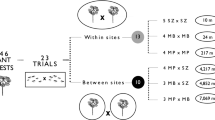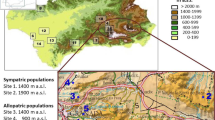Abstract
Unicoloniality emerges as a feature that characterizes successful invasive species. Its underlying mechanism is reduced intraspecific aggression while keeping interspecific competitiveness. To that effect, we present here a comparative behavioural and chemical study of the invasive ant Wasmannia auropunctata in parts of its native and introduced ranges. We tested the hypothesis that introduced populations (New Caledonia archipelago) have reduced intraspecific aggression relative to native populations (e.g., Ilhéus area, Brazil) and that this correlates with reduced variability in cuticular hydrocarbons (CHCs). As predicted, there was high intraspecific aggression in the Brazilian populations, but no intraspecific aggression among the New Caledonian populations. However, New Caledonian worker W. auropunctata remained highly aggressive towards ants of other invasive species. The chemical data corresponded with the behaviour. While CHCs of ants from the regions of Brazil diverged, the profiles of ants from various localities in New Caledonia showed high uniformity. We suggest that in New Caledonia W. auropunctata appears to behave as a single supercolony, whereas in its native range it acts as a multicolonial species. The uniformity of recognition cues in the New Caledonia ants may reflect a process whereby recognition alleles became fixed in the population, but may also be the consequence of a single introduction event and subsequent aggressive invasion of the ecosystem. Chemical uniformity coupled with low intraspecific but high interspecific aggression, lend credence to the latter hypothesis.

Similar content being viewed by others
References
Armbrecht I, Jimenez E, Alvarez G, Ulloa-Chacón P, Armbrecht H (2001) An ant mosaic in the Colombian rain forest of Choco (Hymenoptera: Formicidae). Sociobiology 37:491–509
Armbrecht I, Ulloa-Chacón P (2003) The Little Fire ant Wasmannia auropunctata (Roger) (Hymenoptera: Formicidae) as a diversity indicator of ants in tropical dry forest fragments of Colombia. Environ Entomol 32(3):542–547
Astruc C, Malosse C, Errard C (2001) Lack of intraspecific aggression in the ant Tetramorium bicarinatum: a chemical hypothesis. J Chem Ecol 27:1229–1248
Bolton B. (1977) The ant tribe Tetramoriini (Hymenoptera: Formicidae). The genus Tetramorium Mayr in the Oriental and Indo-Australian regions, and in Australia. Bull Br Mus (Nat. Hist.) Entomol 36:67–151
Clément J-L (1986) Open and closed societies in Reticulitermes termites (Isoptera, Rhinotermidae). Geographic and seasonal variations. Sociobiology 11:311–323
Giraud T, Pedersen JS, Keller L (2002) Evolution of supercolonies: the Argentine ants of southern Europe. Proc Natl Acad Sci USA 99:6075–6079
Holway DA, Suarez AV, Case TJ (1998) Loss of intraspecific aggression in the success of a widespread invasive social insect. Science 282:949–952
Human KG, Gordon DM (1999) Behavioral interactions of the invasive Argentine ant with native ant species. Insectes Soc 46:159–163
Jourdan H, Sadlier RA, Bauer AM (2001) The impact of the little fire ant invasion (Wasmannia auropunctata (Roger) on the New Caledonian herpetofauna: results of a study in sclerophyll forest habitat. Sociobiology 38:283–301
Jourdan H, Bonnet de Larbogne L, Chazeau J (2002) The recent introduction of the neotropical ant Wasmannia auropunctata (Roger) into Vanuatu archipelago (Southwest Pacific). Sociobiology 40(3):483–509
Keller L, Cherix D, Ulloa-Chacón P (1989) Description of a new artificial diet for rearing ant colonies as Iridomyrmex humilis, Monomorium pharaonis and Wasmannia auropunctata (Hymenoptera; Formicidae). Insectes Soc 36:348–352
Le Breton J, Chazeau J, Jourdan H (2003) Immediate impacts of invasion by Wasmannia auropunctata (Hymenoptera: Formicidae) on native litter ant fauna in a New Caledonian rainforest. Aust Ecol 28:204–209
Le Breton J, Delabie J, Chazeau J, Dejean A, Jourdan H (2004) Experimental evidence of large-scale unicoloniality in the tramp ant Wasmannia auropunctata (Roger). J Insect Behav 17(2):263–271
Lenoir A, Fresneau D, Errard C, Hefetz A (1999) Individuality and colonial identity in ants: the emergence of the social representation concept. In: Detrain C, Deneubourg J-L, Pasteels J-M (eds) Information Processing in Social Insects. Birkhäuser Verlag, Basel, pp 219–237
Liang D, Silverman J (2000) “You are what you eat”: diet modifies cuticular hydrocarbons and nestmates recognition in the Argentine ant, Linepithema humile. Naturwissenschaften 87:412–416
Majer JD, Delabie JHC (1999) Impact of tree isolation on arboreal and ground ant communities in cleared pasture in the Atlantic rain forest region of Bahia, Brazil. Insectes Soc 46:281–290
Passera L (1994) Characteristics of tramp species. In: Williams DF (ed) Exotic ants: Biology, Impact, and control of introduced species. Westview Press, Boulder, pp 23–43
Suarez AV, Holway DA, Case TJ (2001) Patterns of spread in biological invasions dominated by long-distance jump dispersal: insights from Argentine ants. Proc Natl Acad Sci USA 98:1095–1100
Suarez AV et al (2002) Spatiotemporal patterns of intraspecific aggression in the invasive Argentine ant. Anim Behav 64:697–708
Tsutsui ND, Suarez AV, Holway DA, Case TJ (2000) Reduced genetic variation and the success of an invasive species. Proc Nat Acad Sci USA 97:5948–5953
Tsutsui ND, Suarez AV (2003) The colony structure and population biology of invasive ants. Cons Biol 17:48–58
Tsutui ND, Suarez AV, Grosberg RK (2003) Genetic diversity, asymmetrical aggression, and cooperation in a widespread invasive species. Proc Natl Acad Sci USA 100:1078–1083
Vander Meer RK, Morel L (1998) Nestmate recognition in ants. In: Vander Meer RK, Breed M, Winston M, Espelie KE (eds) Pheromone communication in social insects. Westview Press, Boulder, pp 79–103
Wetterer JK, Porter SD (2003) The little fire ant, Wasmannia auropunctata: distribution, impact, and control. Sociobiology 42:1–41
Acknowledgements
We thank the Brazilian Cocoa Research Centre (CEPEC/CEPLAC) and its technician Jose Raimundo Maia dos Santos for field assistance. JHCD acknowledges the Brazilian Council of Research (CNPq) for his research grants (process 550701/02-8). We thank Pr. Luc Passera for providing Linepithema humile colonies and four anonymous referees for helpful comments. Thanks to Raymond Jegat and Celine Glaude for assistance in the laboratory. Thanks to Naomi Paz for editing the English
Author information
Authors and Affiliations
Corresponding author
Rights and permissions
About this article
Cite this article
Errard, C., Delabie, J., Jourdan, H. et al. Intercontinental chemical variation in the invasive ant Wasmannia auropunctata (Roger) (Hymenoptera Formicidae): a key to the invasive success of a tramp species. Naturwissenschaften 92, 319–323 (2005). https://doi.org/10.1007/s00114-005-0628-y
Received:
Accepted:
Published:
Issue Date:
DOI: https://doi.org/10.1007/s00114-005-0628-y




